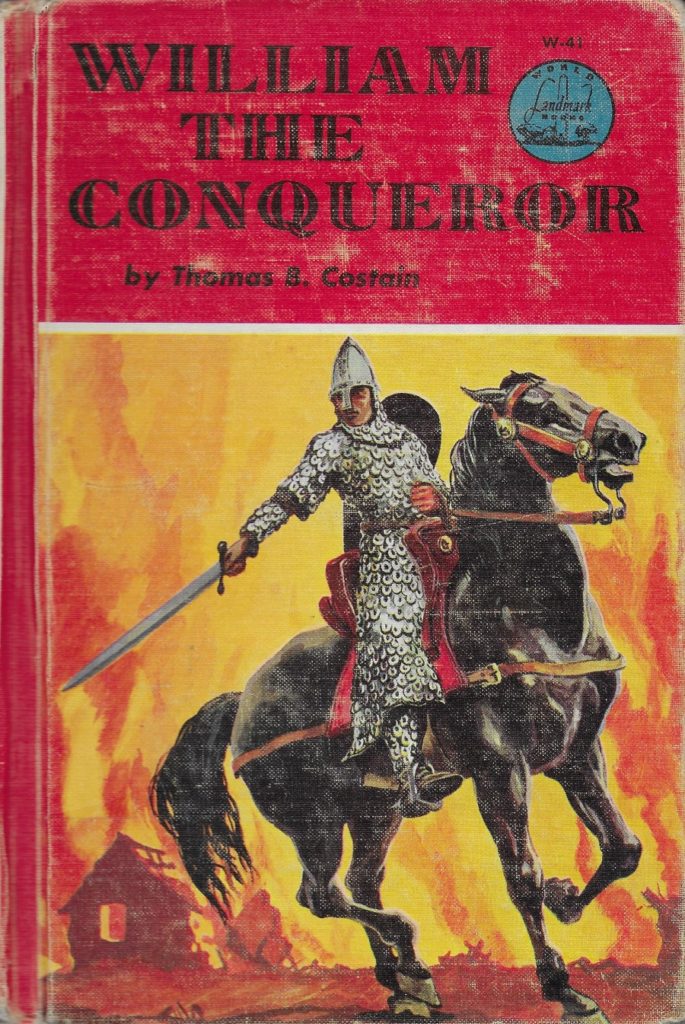
The Landmark Books series was a staple of public libraries throughout the United States in the 1950s and 1960s. Geared towards elementary and middle-school students, they provided accessible and entertaining accounts of a range of historical topics. While the books initially focused on American subjects, a spinoff series, “World Landmark Books,” took on everything from the pharaohs to the Korean War. For a generation of readers, they served as their introduction to the subject – and quite possibly the only book they might ever read about it.
Among the subjects of the World Landmark series was William the Conqueror. To tell the story of his life the editors turned to Thomas Costain, a Canadian journalist who became a prolific author of books. While the author of over a half-dozen works of English history, he enjoyed his greatest success as a historical novelist, with Black Rose, his tale of an Oxford student in the time of Edward I who falls in love with an escaped harem girl while on his way to China, becoming a runaway success when it was published in 1945.
Given Costain’s background, it’s easy to see why he would be commissioned to write a biography of William for a series geared towards young readers. His literary skills are on full display in its pages, as he turns the story of William’s life into an extended account of derring-do. The dramatic is emphasized throughout the book, from the opening chapter when his father Robert (whom Costain insists on identifying as “Robert the Devil” without explaining the legend associated with it) introduces young William as his successor before his fateful trip to the Holy Lands. From there William survives a series of narrow escapes from death (which are played up in a way that might have given George R. R. Martin pause) as he matures into a strapping young warrior renowned for his strength and wisdom.
While Costain describes the Norman background and William’s fight to control Normandy, his focus is very much on the William’s quest for the English throne. His description of 11th century England leans into facile depictions that were outdated even when he wrote them: Æthelred is dismissed as “a weak and slack ruler,” while medieval hagiographers would have little reason to quibble with his description of Edward the Confessor. Though Harold’s oath-breaking receives a disproportionate amount of attention, he is otherwise portrayed surprisingly sympathetically.
Nevertheless, Costain’s emphasis is on the validity of William’s claim to rule England. This he portrays as a lifelong ambition, with many longing gazes across the English Channel. The story of the Conquest takes up roughly half of the book, with the focus after the battle of Hastings on William’s pacification campaigns and Hereward’s resistance in particular. By contrast Normandy disappears from Costain’s narrative, despite the fact that it remained the focus of his activities for the remainder of his life. Whether this was Costain’s choice or an editorial one made with the book’s audience in mind, it leaves the reader with a distorted sense of William’s life as he lived it.
This is not the only questionable choice in the book, however. Far more problematic is Costain’s indulgence throughout it in artistic license. The book is seeded with dialogue of doubtful validity, as well as descriptions of inner thoughts and feelings that are pure invention on the author’s part. While this contributes to the elements of the narrative that make it an engaging read – undoubtedly a key goal of Costain’s work – they create a “William the Conqueror” in his book that is more the product of his imagination than of the available accounts.
As admirable as Costain’s effort is to create a biography of William that appeals to children, it results in a figure that is in many ways more of a caricature than an accurate portrayal of the man. His reliance on the cringeworthy tale of William’s forceful courtship of Matilda is perhaps the best example of this: a likely apocryphal event that is presented as fact and even as acceptable behavior because of its result. For Costain, it seems, the truth should never get in the way of a good story, no matter how distorting it may prove. While this approach may have made for a book that entertained many young readers, it certainly doesn’t result in one that deserves to be read today.
